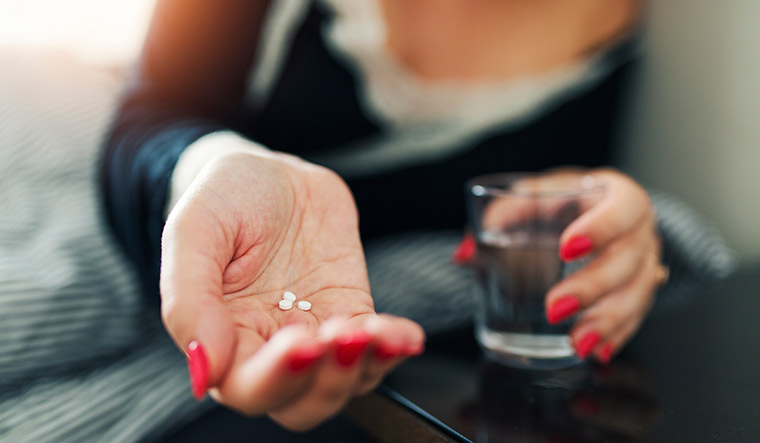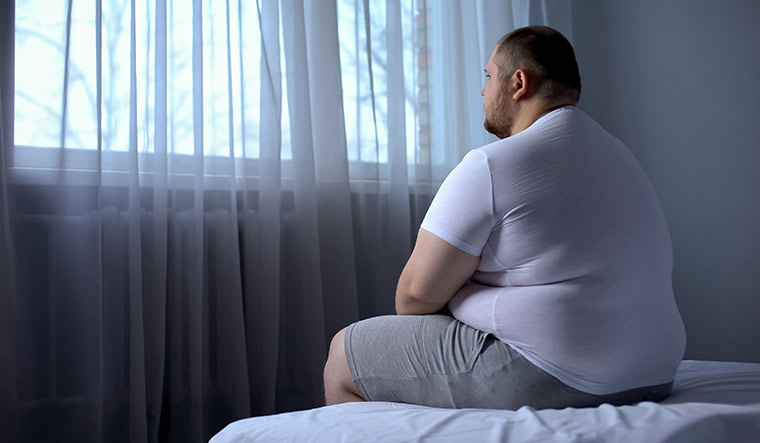HAVING A PARENT or sibling with dementia can increase a person’s future risk of dementia by nearly 75 per cent compared to someone without a family history.
According to a study presented at the American Heart Association’s Epidemiology, Prevention, Lifestyle and Cardiometabolic Health Conference 2021, following a healthy lifestyle can lower dementia risk even among people who have an increased risk due to family history.
The study included 3,02,239 participants aged 50 to 73 years, who completed a baseline physical examination at the start of the study. None of the adults had dementia. They answered questions about family history and lifestyle behaviours.
The participants got one point for each of six healthy lifestyle behaviours they followed, including: eating a healthy diet with more fruits and vegetables, and less processed meat and refined grains; getting at least 150 minutes of moderate-to-vigorous physical activity a week; sleeping six to nine hours each night; drinking alcohol in moderation; not smoking; and not being obese.
Over eight years of follow up, 1,698 participants developed dementia.
Those with a family history of dementia had about a 70 per cent increased risk of dementia compared to those without. But the risk of dementia was reduced with the number of healthy lifestyle behaviours followed.
Those who followed all six healthy lifestyle behaviours cut their risk of dementia by nearly half compared to those who followed two or fewer healthy behaviours.
Do sleep medicines work?
NEARLY 40 PER CENT of people who start taking sleep medications continue to take them for years. While prescription sleep medications may work for short durations, new research published in the journal BMJ Open finds that long term use of these drugs does not provide better sleep quality. The researchers compared 238 women who took medications for sleep problems with 447 women who had sleeping problems but did not take any medication.
The medications included benzodiazepines, Z-drugs which include zolpidem, zaleplon and eszopiclone, as well as other drugs used to treat anxiety and depression. At the start of the study, all the participants reported sleep problems, such as difficulty falling asleep, staying asleep or waking up too early.
After a year or two, women who took sleep medications did not report better sleep quality or sleep duration than those who did not take any medications.
Sleep medications have side effects including daytime sleepiness.
OCD triples a person’s risk of stroke
PEOPLE WHO SUFFER from obsessive compulsive disorder, commonly known as OCD, are over three times more likely to suffer a stroke than those without the condition.
For the study published in the journal Stroke, Taiwanese researchers compared stroke risk between 28,064 adults with OCD and 28,064 adults who did not have OCD for up to 11 years.
Men and women with OCD were more than three times as likely to suffer an ischaemic stroke (caused by a blood clot) compared to adults who did not have OCD. The risk was greatest among adults aged 60 and older.
OCD was an independent risk factor for ischaemic stroke even after accounting for other risk factors that can increase stroke risk, including obesity, heart disease , smoking, hypertension, high cholesterol and type 2 diabetes . Medications used to treat OCD did not appear to increase the risk of stroke.
Did You Know?
Continuous skin-to-skin contact with mothers immediately after delivery (immediate Kangaroo Mother Care) can reduce mortality by 25 per cent in babies with a very low birth weight.
The New England Journal of Medicine
Check heart condition with thumb-palm test
A SIMPLE THUMB-PALM test can be used to identify people who are at a higher risk of having a hidden ascending aortic aneurysm, which could be fatal.
An aortic aneurysm is an abnormal bulge in the aorta, the largest artery that carries blood from the heart to your body. Aortic aneurysms are often hard to detect in advance, before it ruptures and becomes fatal.
The test involves flexing the thumb as far as possible across the palm. People whose “thumb crosses beyond the far edge of the flat palm”may have a hidden aneurysm.
“Being able to move the thumb in that way is an indication that a patient’s long bones are excessive, and their joints are lax—possible signs of connective tissue disease throughout the body, including the aorta.”
The test was conducted in 305 patients undergoing cardiac surgery for a variety of disorders, including aortic aneurysms.
While the majority of aneurysm patients did not manifest a positive thumb-palm sign, those who did have a positive sign were extremely likely to have an ascending aneurysm.
The study was published in the American Journal of Cardiology.
Pill of hope
ASTRAZENECA’S DRUG Olaparib (sold under brand name Lynparza) reduced the risk of relapse and death in breast cancer patients with BRCA1 or BRCA2 mutations, according to findings published in the New England Journal of Medicine.
The OlympiA phase III trial included 1,836 women and men with early-stage breast cancers who had been treated with standard care therapies, such as surgery, chemotherapy, hormone therapy, or radiation therapy.
About 82 per cent of the patients had triple-negative breast cancer.
They were randomly assigned to take either 300mg of Olaparib or a placebo twice a day for a year. After three years, 86 per cent of patients who took the pill were alive without cancer recurrence compared to 77 per cent in the placebo group.
The drug reduced the risk of cancer recurrence or death by 42 per cent compared to the placebo.
Common side effects included nausea, anemia, fatigue and lower white blood cell counts.
The drug is already used to treat breast cancers that have spread throughout the body and for treating certain cancers of the ovaries, prostate, and pancreas.
Did You Know?
Just one glass of wine, beer or any other alcoholic beverage can double the risk of suffering an episode of atrial fibrillation within the next four hours. The risk was threefold for people having two or more drinks in one sitting.
Study presented at the American College of Cardiology’s 70th annual scientific session
Good news for Parkinson’s patients
THE BENEFITS of deep brain stimulation (DBS) last for more than 15 years for patients with Parkinson’s disease, according to a French study published in the journal Neurology.
Most of the symptoms of Parkinson’s disease are due to the gradual loss of a chemical in the brain called dopamine. Patients with Parkinson's disease often take the drug levodopa which can temporarily restore dopamine and help relieve symptoms which affect their speech, walking and balance.
But the levels of dopamine can fluctuate through the day, leading to dyskinesia, a side effect of levodopa that can cause involuntary movements such as wriggling, twitching, swaying or head bobbing.
In deep brain stimulation, electrodes are placed in specific areas of the brain and are connected to a stimulator device that is placed under the skin of the chest. Similar to a heart pacemaker, the neurostimulator uses electrical pulses to regulate brain activity and control Parkinson's symptoms such as tremor, slowing down of movement, stiffness, and walking problems.
The findings of the study were based on 51 patients who had the device implanted for an average of 17 years. The average age of diagnosis of Parkinson’s disease was 40 and for device implantation was 51.
The researchers compared data from before the implant, at one year, and beyond 15 years after surgery. The amount of time participants experienced dyskinesia was reduced by 75 per cent after the device was implanted.
The use of medications to control dopamine levels was reduced by 51 per cent, and the amount of time when medication was no longer working well dropped by 59 per cent.
Alcohol consumption can lower chances of pregnancy
WOMEN SHOULD limit alcohol consumption if they are planning to get pregnant, suggests a US study published in the journal Human Reproduction that examined the link between alcohol intake and the chances of conceiving during a single menstrual cycle.
The researchers followed 413 women aged 19 to 41 years for a maximum of 19 menstrual cycles.
Heavy drinking during any phase of the menstrual cycle was significantly associated with reduced chances of conception. Both moderate (three to six drinks per week) and heavy (greater than six drinks per week) drinking during the luteal phase—the last two weeks of the menstrual cycle before bleeding would start and when the process of implantation occurs—was associated with a 44 per cent reduction in the odds of conceiving, compared to abstaining from alcohol.
Heavy drinking during the ovulatory phase of the cycle was associated with a 61 per cent reduced odds of becoming pregnant.
Each extra day of binge drinking (four or more drinks on a single day) was associated with a 19 per cent reduction in the odds of conceiving during the luteal phase and a 41 per cent reduction during the ovulatory phase.
Did You Know?
Adolescents and young adults with Covid-19 can suffer from symptoms of chronic fatigue syndrome—such as extreme fatigue and light headedness—months after their infection, even if their infection was mild.
Frontiers in Medicine
Sit less to keep the pounds away
WHAT IS THE secret to keep the pounds from creeping back after losing weight? Sit less and move more.
The study published in the journal Obesity included 4,305 people who had lost weight and kept off at least 9.1 kg for 3.3 years.
The researchers compared their sitting habits with a group of people who were obese and remained obese during the study period.
Those who kept their weight off sat for three fewer hours each day. They spent one hour less per day sitting at a computer, playing video games or watching TV. They also burned significantly more calories per week in physical activity.
“Finding ways to sit less and move more is part of the successful package of tools for weight management. Engage in planned physical activity, and also pay attention and interrupt any extended periods of sitting,”said the study author.
Alternative antidepressant
NITROUS OXIDE, the anesthetic drug commonly known as laughing gas, might be a safe and effective alternative to treating people suffering from severe depression.
The findings of a phase 2 clinical trial published in the journal Science Translational Medicine showed that symptoms of depression improved rapidly and significantly after just one treatment session and the benefits lasted several weeks.
The study included 24 patients aged 18 to 75 who did not respond to standard treatments.
All the patients received three treatments about a month apart. In the first session, patients were exposed to an hour of 50 per cent nitrous oxide and 50 per cent oxygen inhalation treatment; the second session included 25 per cent nitrous oxide; and the third session involved breathing only oxygen, with no nitrous oxide.
Out of the 20 people who completed all three treatment sessions and follow-up exams, 55 per cent experienced significant improvement in at least half their depressive symptoms and 40 per cent were no longer clinically depressed.








